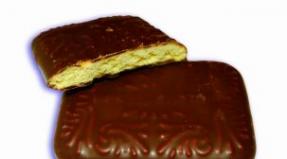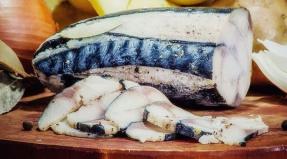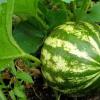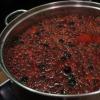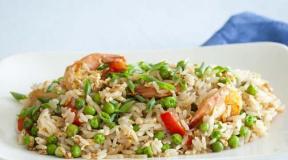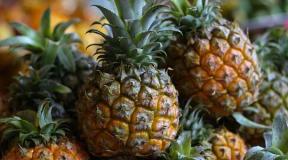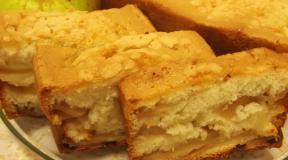Olivier appeared. From "Olivier" to "Stolichny" salad
The culture
Have you ever wondered why many people love Olivier salad so much? And why exactly this dish is so popular on the territory of the former USSR, associated with New Year's festivities?
And after all, even those who hate Olivier are well aware of the peculiar sacred meaning this salad for almost everyone who loves the New Years holiday (that is, for the majority).
The special status of Olivier salad as a dish for a holiday is perceived by us as such from early childhood. And it seems as if it had always been this way. In fact, the popularity of Olivier in our country is a vivid example of such a random product placement.
Where did such a dish come from? A lot has been written about its origin, but too much artistic most stories look, raising a lot of questions.
So how did the "bourgeois" salad penetrate the life of almost every citizen of the former USSR? Why exactly salad olivier became the most beloved New Year's dish for many millions? Let's talk about everything in order.

The history of the birth of Olivier salad usually begins with the history of the birth of a person, a great hereditary cook. And this man was a certain Lucien Olivier... It is believed that Lucien was born in Moscow somewhere at the turn of 1837-1838 (nothing is known about the exact date of the birth of the future "father of Olivier salad").
The sources, which mention the name of Lucien Olivier, usually immediately transfer us to the mid-60s. the century before last when well-to-do Muscovites and guests of the city gave their attention to a restaurant called "Hermitage".
It was in this restaurant that visitors tried for the first time the prototype of the Olivier salad, named after allegedly hereditary chef(and part-time manager) this institution Lucien Olivier. But this is where the first questions arise.
There is no evidence that Lucien Olivier was a hereditary chef
You might be surprised, but there are no reliable sources that would confirm that restaurant manager Lucien was a great cook (and even hereditary, as you can read in some "historical" research), does not exist.

And what is generally known about Lucien? The man is believed to be French or Belgian French origin... However, here too we face with the same problem: no matter how hard you try, you will not find a reliable primary source of this information (and many enthusiasts and historians were deliberately engaged in this).
And what do the Moscow archives say about people with the surname Olivier, who then lived in this city? It is known for certain that in the address book of 1842 of the year there is a mention of only one Olivier, who was then living in Moscow. Perhaps the "great cook" was born in his family?
That is unlikely. The likelihood that it was in the family of this Olivier, a merchant and owner of a hairdresser named Osip, then grew up four-year-old Lucien, the future creator of the super-popular salad, is practically nil: although Osip had four children and three of them are boys, none of the guys are suitable either by age or by name.
Was there even a man named Lucien Olivier?
For most of the fragmentary information that we have about Lucien Olivier, as the manager of the Hermitage restaurant, we owe to such a person as the writer Count Vladimir Gilyarovsky... And it would be possible to refer to his information, if not for one "but": Gilyarovsky was called at one time only as a collector of urban legends. Legends and rumors.

And, nevertheless: if you believe all the same archival sources (namely, they are the most reliable), the Hermitage restaurant, which opened in chic hotel "Hermitage" on Trubnaya Square in Moscow, like the hotel itself, were under the management of a certain ... Nikolai Olivier. Another Olivier? Where did he come from ?!
Nicholas Olivier was first mentioned in 1868 in a way Moscow guidebook hospitals, shops, various enterprises, educational institutions, usurers' offices, as well as hotels and restaurants.
Who was the first to tell about Lucien Olivier as a cook?
The writer Gilyarovsky, in his descriptions of the life and traditions of Muscovites of those years, described the Hermitage establishment as a very popular and elite place... And it was he, Vladimir Alekseevich Gilyarovsky, who painted the talents of the cook Olivier, who allegedly cooked exclusively delicious salad, which made Lucien popular throughout Moscow.

Gilyarovsky personally, of course, could not see this, since he was born only in 1855; his book "Moscow and Muscovites" was published in 1926. And now the most interesting thing: any other sources of information, about whom we would have learned about Lucien Olivier as a talented hereditary chef, are simply absent.
However, the manager of the Hermitage named Lucien existed, being, quite obviously, Nicholas, who changed his name to a more French one. What for? Perhaps to match The "Frenchness" of the restaurant itself... One can only guess about the motives of Nicholas (Lucien), since the man died in 1883, leaving almost no data behind.
Could the manager of the hotel and restaurant take on himself the preparation of meals in the restaurant of the hotel he runs? Hypothetically, such a possibility is not excluded, however no evidence We do not have this fact, except for the existence of a beautiful legend about the hereditary chef Lucien Olivier (and many conjectures based on this legend). But we have Olivier salad.
Real Olivier recipe
Olivier's first salad
The question immediately arises: maybe there was no Olivier salad then? There was, although the story of Olivier, like a salad, no less confusing than the story of Lucien Olivier as a cook. There were many delicious dishes, which the sophisticated Moscow noble public really tried for the first time in the Hermitage restaurant in the hotel of the same name.

By the way, another Russian writer, Pyotr Dmitrievich Boborykin, who lived in that era and visited the Hermitage restaurant, sincerely admired the incredible huge kitchen this institution in their articles published in the popular monthly. There was also mentioned a French manager, allegedly born in Russia.
At the same time, as Bobrykin assured, insisting on this information, about six dozen chefs... Did it make sense for the hotel manager to stand behind the stove?
However, back to the salad, or rather, to its prototype!
The Hermitage restaurant served delicious and varied dish(perhaps really salad), which later came to be called by the name of the manager restaurant. Perhaps it was called so at once, in the restaurant's menu, although there is no indication of this.
What the first recipe for this dish looked like, did it look like a salad at all - unknown! Everything else that can be found about the Olivier salad with reference to the Hermitage restaurant is stories, legends and speculation.
One of these legends says that the restaurant's chef (according to the same legend, the chef was Lucien Olivier) served his new cooking masterpiece which was not a salad at all. Rather, it was a kind ensemble of various products , generously drizzled with Provencal sauce. The dish allegedly included crayfish necks, partridges, hazel grouses, lanspig, veal tongue and much more, including separately presented potatoes and eggs.

Some of these products are actually used as ingredients for modern salad Olivie. But, as the legend says, visitors to the Hermitage did not appreciate refined taste artist and maestro Olivier, mixing all the ingredients in a bunch... And the next day, the chef, upset by the ignorance of the public, served the same dish, but in a mixed form. Like, this is how the Olivier salad appeared.
One would like to believe in this memorable legend, but there is one nuance (at least): the dish itself was allegedly called "Game Mayonnaise". but cookbooks the middle of the century before last present us under this name a lot of dishes from pork, beef, hare, and other animals. It seems that mayonnaise became a sauce later.
Where did you disappear to original recipe Olivie?
After Olivier's death, the Hermitage restaurant was repeatedly repaired, completed, rebuilt, after which it was finally closed in 1917. Have any recipes been lost? It is obvious. Was there a recipe for that famous Olivier salad among them? As you can imagine, there is no direct indication of this. But the story did not end there, but only began.

Starting from 1884, recipes began to appear in various culinary and near-culinary publications of the country, which are supposedly a reference to "the very same" famous recipe Olivier salad, popular among the nobility of Moscow and guests of the city. The recipes changed from publication to publication and from publication to publication.
The authors of each subsequent recipe could make changes to the "original" recipe, replacing, for example, hazel grouse with chicken, recommending Provencal sauce. By the way, standards for mayonnaise, as for the sauce familiar to us, called "Provencal", were developed already in the Soviet Union. By the way, there were no preservatives in it, except for vinegar from alcohol.
Needless to say that among the writers culinary recipes, as well as among publishers and editors, there were many not the most talented people who, first of all, hoped to to make money? Not trying hard to look for any historical truth, some even invented the ingredients of the "first Olivier" (adding, for example, black caviar).
Salad for the New Year's table
Soviet Olivier
Glory to the Olivier salad, as " unique dish with incredible taste and nutritional qualities whose recipe was irretrievably lost, "just could not sink into oblivion... And she did not sink. V famous restaurants Soviet Union many chefs have tried to speculate (in a good way) on the long-standing fame of Olivier salad.

Speculation can be called purely conditional, since the chefs of the establishments sincerely tried to cook something close to the original(at least close to what was published in the old pre-revolutionary culinary publications).
Ideologically correct Olivier
It is known, for example, that in the mid-30s of the last century in some restaurants of the capital, salad a la Olivier was no longer served with expensive ingredients, echoes of the bourgeois past (take at least the same hazel grouse!), but with ideologically verified red carrots. And he was called "Capital".
Perhaps the story about the "ideologically verified" carrot is also a legend, and the chefs simply had to try new ingredients including the same green peas instead of capers. And the sausage that appeared in the dish was the result of attempts to reduce the cost of the final product.
It must be said that already by that time the Olivier salad was known under several names: "Russian salad", "Winter". Again, "Stolichny". There is no clear justification for this. One can come across fabrications on the theme that “Russian” differs from “Olivier” in that one uses meat, and the other uses sausage.
However, there is no logic in this, given the previous narration. Most likely, in the Soviet public catering system, they tried to get away from not quite popular name"Olivier", trying not only new ingredients, but also new names... As we can see, one, the second, and the third have taken root. There are even names like "Game Salad".

How did it appear in Olivier doctor's sausage?
After the end of the Great Patriotic War, the Soviet people were actively rebuilding the destroyed country. But even in the midst of harsh everyday life, sometimes I wanted to arrange a holiday for myself - with festive food and drinks... Olivier unexpectedly became an attribute of the celebration. But since chicken fillet was expensive, cheaper doctor's sausage began to be used everywhere.
Moreover, this boiled sausage developed back in 1936 as an element diet food recommended for those who undermined my health even as a result of the Civil War and the First World War, it was recommended to citizens at the end of the Great Patriotic War.
Many people know and love Olivier. People call him “ meat salad". Also in Soviet time he was present at every festive table and was considered an integral part of the feast. In those days, few people were worried about the history of Olivier salad, the main thing was that it was tasty and nutritious. Each time the hostesses prepared a "meat salad" according to a single recipe that everyone knew. Over time, chefs began to add their own special ingredients, with each claiming that their cooking option was the right one. That is why the question often arises of what really needs to be put in the Olivier salad. The origin story will help open this veil.
Monsieur Lucien Olivier
Before giving the laurels to the salad maker, you should find out who he was. I wonder what life talented chef just explain to us why this culinary masterpiece is so popular among the Russian people, and we will know real story salad olivier. The name of the creator of this dish was Lucien Olivier, he was a Frenchman, capable of culinary arts. He was born in 1838. He also had two older brothers who cooked equally tasty. But they chose to stay in their homeland. In his youth, Lucien went to Moscow to earn extra money. He chose this particular country, because he knew that the Russian people were interested in it. It was here that Olivier began. It should be noted right away that an improved recipe for Provencal mayonnaise was born in this family, which Lucien used in his kitchen. Olivier started his business by opening own restaurant The Hermitage, which was a huge success at first.
The secret of the restaurant

Lucien quickly gained popularity. All this was made possible thanks to mayonnaise, to which he added mustard in the correct proportions and a few spices, which gave the sauce an original spice. Huge demand prompted the culinary specialist to open another restaurant on the same success enjoyed his brothers in France and also were able to start their own business.
Olivier: the history of a culinary masterpiece
As you know, if you eat one sausage, it soon gets bored, and you want to try something new. The same principle worked here: people got tired of this piquant monotony, and the number of customers in the restaurant was getting smaller. It was thanks to this that Lucien began to think about a new interesting dish that would attract customers. In the course of culinary experiments, he was born new recipe, now known to everyone as Olivier salad. The history of the origin of this dish is so interesting that I just can't wait to try it. But it is known that today's salads are fundamentally different from the one that was created at the beginning. It was exquisite and something unusual, something that brought back the popularity of the Hermitage, and its owner - the glory of a great culinary specialist. Admirers of this dish have named it Olivier. The story doesn't end there.
Original recipe

Lucien himself called the dish he created "Game Mayonnaise" and could not call it by his own name - "Olivier". Classic recipe At first, the French chef did not change, and it consisted of well-cooked meat of partridges and hazel grouses, between them he put jelly, which remained from the broth. He also cut the tongue of a young calf into pieces and laid it out along the edges, alternating with small ones. Then he watered it not big amount mayonnaise, which he made with his own hand. There was a place in the center, which he filled with coarsely chopped eggs and gherkins. All this he served to visitors who enjoyed such a combination.
Olivier's secret
The history of the creation of this dish, one might say, was just beginning. Many chefs and just housewives tried to repeat this recipe in their kitchens, but, to their surprise, nothing worked. Many tried to find out what the secret was, but Lucien cooked the dish alone, indoors, without revealing his secrets. In fact, the secret was in the very mayonnaise that the restaurant visitors have recently become boring.
A gourmet dish turns into a salad

Lucien tried to make his new dish not only tasty, but also original in appearance. But soon he had to make some adjustments and change its external beauty, and this did not make the salad less in demand. The fact is that the ingredients that were placed in the center of the plate were, rather, intended for decoration. But the Russian person does not have the mentality to leave food untouched. This is precisely what is reflected in the fact that the history of the origin of Olivier has changed a little. Once Lucien noticed that his visitors mix all the ingredients and only then eat them. He realized that food is not as important for the Russian people as its taste, so he interpreted own recipe... Now the chef cut all the ingredients into slices, poured enough branded mayonnaise and mixed everything well. The Russian man now has an exquisite and beloved Olivier salad. The French chef took the classic recipe with him without giving away the secret. The great culinary specialist died in 1883.
New life of salad
We can say that the history of Olivier salad did not end here either. Although Lucien never revealed the original recipe to anyone, in 1904 the dish was "reconstructed".

One former visitor to the restaurant remembered all the ingredients that the creator of this masterpiece added. The only discrepancy was only in the composition of the Provencal sauce, to which Lucien added his "secret" spices. So in new salad included the following components:
- fillet from two boiled hazel grouses;
- 25 crayfish;
- one veal tongue;
- half a can of soybean kabul;
- half a can of pickles;
- 200 grams of lettuce (fresh);
- 100 grams of pressed caviar (black);
- two fresh cucumbers (crumble);
- 5 hard-boiled eggs;
- 100 grams of capers.
All components were filled with a special French Provencal. It was made from 400 grams of olive oil, vinegar and two fresh yolks. These ingredients were sourced from France.
Having considered what the history of the Olivier salad was, having briefly learned about its origin, many will notice that modern dish is fundamentally different from the one that was originally served.

This is not surprising, since in Soviet years people did not have such an abundance of food on their tables that wealthy restaurant owners and nobles could afford. Has gained popularity with most families new variant Olivier, which many still use. Almost everyone loves him since childhood. Here is its recipe:
- 4 hard eggs;
- a pound of Doctor's sausage;
- 4 boiled potatoes;
- 4 pickled cucumbers;
- a can of canned peas;
- a pack of provencal;
- greens and salt if desired.
All components are finely chopped, mixed and seasoned famous sauce... Here, everyone's favorite Soviet-era dish is ready!
Interpretations of lettuce

Today Olivier has a different name and is better known as "meat salad". That is why many remembered that sausage should not be added to it, but white meat should be put. Since it is difficult to get partridges and hazel grouses, housewives boil With this ingredient, many types of Olivier have been created, which differ in their composition. Now they put carrots, apples, onions in salads. Other components, on the contrary, are removed. Here is one of the recipes for a modified Olivier:
- 4 eggs;
- 4 potatoes;
- 1 apple;
- 1 onion;
- 1 breast;
- 1 can of peas;
- 3 pickled cucumbers;
- 2 carrots.
Vegetables are boiled and cut as usual. Breast and eggs are also boiled and minced. Onions and cucumbers are chopped. But it is worth considering that salads to which onions are added are not recommended to be stored for a long time, since this vegetable eventually gives the dish an unpleasant aftertaste. Further, peas are poured into the Olivier. Everything is diluted with Provencal. If necessary, add herbs and salt.
The other option is slightly different. You will still need the same amount of potatoes, eggs, carrots, breast. Put less pickled cucumbers, one is enough, add 100 grams of peas and the same canned olives... Chopped is also added fresh cucumber... Refuel in the usual way.
The third method is interesting in that you need smoked fillet and 200 grams of champignons from a jar. A peeled apple with sourness is also added here, it is chopped small pieces... Then 200 grams of peas, three "uniforms", four eggs. All crushed components are mixed. Olivier is salted and peppery. Next, you need to get 250 grams from the refrigerator fat sour cream, pour a teaspoon into it granulated sugar and salt. This mass is thoroughly whipped, after which 2 tbsp is poured in a thin stream. tablespoons of lemon juice and a tablespoon of brandy. 1 tbsp is poured into the future sauce. spoon nutmeg. Ready mass salad dressing.
The history of Olivier salad is truly amazing - created as delicate dish from fried hazel grouse and crayfish necks, in the Soviet Union, he turned into the main New Year's salad with boiled sausage and green peas... If you ask any housewife what they add to Olivier, the answers will amaze with their diversity - some manage to put tomatoes in the Olivier, others prepare this salad using canned corn... Despite the aristocratic history of origin, the Olivier salad has become the most democratic dish, prepared from products at hand and generously seasoned with mayonnaise.
Olivier salad owes its history to French chef Olivier, who worked in the Moscow restaurant "Hermitage". In the original, this dish was not at all what was cooked and swallowed in basins in the USSR.
Lucien Olivier, glorified by Gilyarovsky, invented a slightly different dish, which combines with our usual Olivier only the presence of mayonnaise and “ meat product". The difference is that the meat was fried hazel grouse cut into strips (or in pure form, or supplemented with veal and partridges). As evidenced by data from the history of the creation of Olivier salad, mayonnaise was, of course, homemade... Molokhovets has a similar dish called game mayonnaise.
The history of the emergence of Olivier salad in Russia
The exact recipe of Olivier himself has not survived, but, according to the recollections of visitors to the Hermitage, in addition to hazel grouses, the salad contained jelly cubes (from partridge broth), gherkins, fresh cucumbers and cool eggs, which were supposed to play a purely decorative role. Olivier was shocked to the core when Russian merchants kneaded the eggs with a fork, mixed them with the rest of the dish and ate. And the main thing that was added to the Olivier salad was crayfish tails and truffles. Apparently, the idea to add to the salad boiled potatoes It did not occur to Olivier (he was still French, not German), but already in Russian cookbooks at the turn of the 19th and 20th centuries, this ingredient appears in recipes. In the gas station, in addition to mayonnaise, fairly diluted olive oil, the mysterious "soy kabul" was added, apparently one of the varieties of soy sauce.
The history of Olivier salad in Russia after the revolution has undergone serious changes. In the 1930s, the salad mutated into Stolichny (this recipe, by the way, also has its author - Ivan Ivanov, the chef of the Moscow restaurant): chicken instead of hazel grouse and no truffles with crayfish tails, which were replaced boiled carrots... The latter allegedly appeared in a "mutant" salad in the restaurant of the House of Writers, where they cut it instead of crabs for the color of USSR literature that had taken on the chest - it is similar in color, but neither prose writers nor poets were able to distinguish them by taste.
Wines for Olivier salad
1. Champagne or other good sparkling wine. According to half of Moscow sommeliers, Olivier goes well with low-dose brut (Brut Naturel) or Italian Franciacorta Dozage Zero, which can cope with eggs and vinegar in mayonnaise.
2. If your salad contains, as it should be, crayfish tails and a red game, then you have a choice of many quiet white wines: a simple New World chardonnay (without oak), Riesling (so that it contains not only acidity, but also good alcoholic component) or the average price of sauvignon blanc (which will be good for an authentic recipe, it will overcome both mayonnaise and hazel grouse). To refined versions of Olivier in restaurant serving advise white burgundy and light sancerre samples.
3. If your Olivier is more meaty, then light red wine will suit it. Among the latest ideas of Moscow chefs are, for example, Olivier with roast beef, smoked duck, veal tongue. This will be good for a red Burgundy regional level (say, pommare). One more appetizing option- Olivier with Tambov ham and pickled apples - simply appeals to the spicy côte du rhône.
4. Rescue option for all cases (including serving in a basin) - fortified wines: sherry amontillado, dry malaga or white port- that is, something not particularly sweet, but with a good "body" and a powerful bouquet.
Considered a festive and traditional New Year's. It got its name in honor of its creator, chef Lucien Olivier, who ran the Hermitage restaurant of Parisian cuisine in Moscow in the early 1860s. Abroad known as "Russian salad" or " Potato salad"(Potato salad, though without meat and peas). Sometimes Olivier is also called meat salad.
History
The earliest publication of an Olivier salad recipe, known at the moment, is given in the magazine "Our food" No. 6, March 31, 1894.
In the book by P. P. Aleksandrova "Guide to the study of the basics culinary arts»1897 edition indicated next recipe :
Olivier salad
Essential products and their proportion per person.
Grouse - ½ pieces. Potatoes - 3 pieces. Cucumbers - 1 piece. Salad - 3-4 leaves. Provencal - 1½ table. spoons. Cancer necks - 3 pieces. Lanspeak - ¼ glass. Capers - 1 teaspoon Olives - 3-5 pieces.
Cooking rules: Cut the fillet of fried good hazel grouse into blankets and mix with blankets of boiled, not crumbly potatoes and slices fresh cucumbers, add capers and olives and pour over a lot of Provencal sauce with kabul soy. After cooling, transfer to a crystal vase, decorate with crayfish tails, lettuce leaves and chopped lanspik. Serve very cold. Fresh cucumbers can be replaced with large gherkins. Instead of hazel grouse, you can take veal, partridge and chicken, but real snack Olivier is certainly prepared from hazel grouse.
According to some reports, the original salad recipe is as follows: 2 hazel grouse, veal tongue, a quarter pound pressed caviar, half a pound fresh salad, 25 boiled crayfish, half a can of pickles, half a can of soybean cabul, two fresh cucumbers, a quarter pound of capers, 5 hard boiled eggs.
For the sauce: Provencal mayonnaise should be cooked on French vinegar from 2 eggs and 1 pound of olive oil.
In Soviet times, the recipes for Olivier salad changed several times, some ingredients were replaced by others, cheaper and more accessible. The standard Soviet Olivier consisted of 6 ingredients:
- boiled potatoes;
- boiled sausage ("Doctor's");
- boiled carrots;
- hard boiled eggs;
- pickled (pickled) cucumbers;
- green peas (canned);
Everything was cut into cubes, mixed and seasoned with mayonnaise. The ease of manufacture and the availability of ingredients have made this salad extremely popular dish in the Soviet years. Olivier was an indispensable attribute of the Soviet festive table on Day of the October Revolution and [a source?] New Year . Other name modern recipe of this salad - "Winter" - arose due to the fact that its ingredients are readily available in the winter, in contrast to the ingredients of "summer" salads. During the years of perestroika, changes took place in the Soviet recipe: the sausage was replaced boiled meat and apples and fresh cucumbers are available as an option. Chicken instead of beef got its name "Capital salad"... Moscow salad is also considered one of the varieties: catering workers added there boiled potatoes a lot. [a source?]
Notes (edit)
Links
- Investigations of S. Olivyushkin: "The case of the secret of Olivier salad."
Wikimedia Foundation. 2010.
See what "Olivier (salad)" is in other dictionaries:
Olivier salad- see Olivier salad ... The fate of the eponyms. Reference dictionary
Salad Salad (dish) (from Italian Salato, Salata, i.e. salty) cold dish made from various vegetables(actually lettuce leaves, various greens, root vegetables, mushrooms, potatoes, cucumbers, beans, fruits, green leaves of endive, water ... ... Wikipedia
This term has other meanings, see Salad. Vegetable salad Salad (Italian Salato, Salata "salty" ... Wikipedia
Lucien Olivier, a cook of French or Belgian origin, who ran the Hermitage restaurant in Moscow in the early 1860s; known as recipe maker famous salad, soon named after its creator. His ... ... Wikipedia
Lucien Olivier (fr. Lucien Olivier, 1838 1883) a cook of French or Belgian origin, who ran the Hermitage restaurant in Moscow in the early 1860s; known as the creator of the famous salad recipe, soon named after ... ... Wikipedia
Olivie- unsl., M. Olivier. In France, such a salad is unknown, it is assumed that it originated from the name of Fr. a chef who worked in Russia. Olivier salad. Chicken, crayfish, potatoes, cucumbers, eggs, salt, pepper, olive oil, green salad. Nezhentseva 1911 ...
V.A. Gilyarovsky in his book “Moscow and Muscovites” recalled: “It was considered special chic when the cook, the Frenchman Olivier, who even then became famous for his“ Olivier salad ”invented by him, without which lunch is not at lunch, and the secret of which he did not open, was considered to be a special chic. ... Culinary vocabulary
Olivier is the first and last name of French origin. Notable carriers: Olivier, Guillaume Antoine (1756 1814) French naturalist, entomologist and botanist. Olivier, Joseph (1874 1901) French rugby player, champion of the Summer Olympics ... ... Wikipedia
salad d "boeuf- * salade de boeuf. He Olivier introduced beef (salad d beef), or fried game (Olivier salad, later called the capital) into the famous Parisian salad with mayonnaise. PIO 1999 5 30 ... Historical Dictionary of Russian Gallicisms
salad olivier- See Olivier ... Historical Dictionary of Russian Gallicisms
Olivier salad- Salad popular in the countries of the former USSR, considered festive and traditional New Year's. It got its name in honor of its creator, chef Lucien Olivier, who kept it in Moscow in the early 1860s.
Abroad, Olivier salad is known as "Russian salad" or "Russian potato salad".
The history of the emergence of salad "Olivier"
Olivier's culinary dynasty lived in the southern province of France - Provence. She did not stand out from hundreds of her own kind, because the culinary profession has always been popular with the French. But at the beginning of the 19th century, she became famous, creating delicious sauce, which was given the romantic name "Provencal". Olivier's three brothers conjured in the kitchens of France, while the younger Lucien went to conquer hospitable Moscow. And men in Russia traditionally preferred pickled mushrooms and cucumbers as snacks, pickled apples and sauerkraut with cranberries. To top off all the troubles, the metropolitan taverns have learned to cook about the same salads, only under sour cream sauce... It was urgent to invent something new. Lucien Olivier arranged a grandiose "culinary-political council" with assistants: chefs Dughet and Marius, who knew well taste preferences the Moscow public.
A few days later, everyone offered their own version of the new salad. But Lucien Olivier decided to create something super-original. He almost never left the kitchen, coming up with new taste: "Heavy" meat was replaced by "light" poultry, introduced apples, peas - everything is not right. And suddenly - eureka! Cucumbers should not be salted, but fresh! .. The taste has been found! It remained to calculate correct proportions and add spicy little things to make the dish so beloved by Russians "overseas extravagance". And this for such a professional as Olivier was a matter of several trials. Soon, Olivier's salad appeared on the menu of the Hermitage restaurant's specialties. A few months later, a rumor spread across the capital that in the Moscow restaurant, which had never before shone original dishes, several masterpieces of the culinary art appeared at once. Among them is the Stolichny salad, which, according to Moscow gourmets, is the closest in terms of taste to Olivier. The name of the chef of the restaurant, contrary to the existing fashion, was absolutely Russian - Ivan Mikhailovich Ivanov. Competition pushed Olivier to search again, and he began to experiment with a vengeance. New combinations of meat, cucumbers and apples were selected, only hazel grouses remained the main ingredient. The following version of "Olivier" has come down to us: 2 equal parts roast veal and hazel grouse fillet, 5 boiled potatoes, a large root of boiled celery, half a can of pitted and pitted olives, half a glass of pickled gooseberries and pitted cherries, 5 salted gherkins, 15 crayfish necks, 300 grams of boiled porcini mushrooms, 4 boiled eggs... You can also add 2 fresh cucumbers.
After Olivier's death, the owner of the Big Hermitage restaurant (that was the name of the tavern at the beginning of the 20th century) was Olivier's Partnership, whose composition changed several times. During the revolution of 1917, the restaurant was closed, the building housed various institutions, during the NEP years there was again a restaurant here, and from 1923 to 1941 it housed the "House of the Peasant". However, the Olivier salad, which ended its history so sadly in its own restaurant, has won a place on the home tables of Muscovites. As you know, its main components are boiled potatoes, boiled sausage, diced, and mayonnaise. For the rest, this salad gives the hostess complete freedom of imagination - one lady, giving the recipe, said: "And I also put everything in the house" ...
Read also ...
- Recipes for making coffee with ice cream at home
- Strawberry panna cotta - a classic of world culinary What is panna cotta with strawberries
- Cream of curd cheese for cake - the best recipes for impregnating and decorating dessert
- Profiterole recipe and three original custard recipes Protein cream for profiteroles
